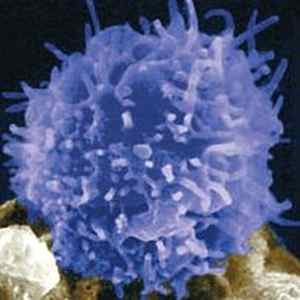

MedFriendly®


T Cell
A T cell (pictued below) is a type of white blood cell
that directs the body s immune (defense) system to
defend against bacteria and other harmful cells. White
blood cells are cells that help protect the body against
disease by fighting infectious organisms. T cells have
receptors that allow them to recognize foreign
substances. There are many different types of T cells.
FEATURED BOOK: Molecular Biology of the Cell
WHAT ARE SOME MORE SPECIFIC FUNCTIONS
OF T CELLS?
A T Cell Under the Microscope
When activated by substances considered to be foreign (e.g., bacteria), T cells increase
in number and perform various functions to help defend the body. One function is to
stimulate and suppress the functions of B cells. B cells are types of white blood cells that
have the ability to recognize antigens, which are substances located on the surface of
invading microorganisms (e.g., bacteria). T cells also suppress certain activities of the
immune system so that it does not mistakenly view normal parts of the body as foreign. T
cells that perform this function are known as suppressor T cells or regulatory T cells.
Another function of T cells is to stimulate helper T cells (also known as CD4 cells), which
are types of white blood cells that release cytokines. Cytokines are proteins that help
other white blood cells communicate with each other.
"Where Medical Information is Easy to Understand"™
Because of the important role helper T cells play in communication,
they can be thought of as the generals of the immune system. While
most of the helper T cells die after the foreign substance has cleared
the body, some remain in the body in a resting state. Those remaining
helper T cells are known as memory cells. By remaining in the body,
memory cells can easily recognize the same foreign substance in the
future since they have already been sensitized to them. Another very
important type of T cells is the killer T cell (also known as a cytotoxic T
cell or CD8 cell). Killer T cells are like the soldiers of the immune
system since they directly attack foreign cells and destroy them. The
process of white blood cells directly defending the body by destroying
assumed foreign substances is known as cell-mediated immunity.

HOW ARE T CELLS MEASURED?
Blood cell tests can be done to count the number of T cells in the body. T cells can also be examined
under a very powerful microscope (known as an electron microscope) and flow cytometry. Flow cytometry
is a technique for counting, sorting, and separating microscopic particles that are suspended in a stream
of fluid.
Such tests can be helpful when attempting to diagnose conditions characterized by a deficient immune
system. An example of such a condition is AIDS (Acquired Immunodeficiency Syndrome). AIDS is a
decrease in the effectiveness of the body's immune (defense) system due to infection from a virus known
as HIV (human immunodeficiency virus). In AIDS, the number of T cells is abnormally decreased. In other
conditions, such as infections and blood diseases, there is an abnormal increase in T cells.
T cell levels can also be helpful when trying to diagnose diseases of the lymphatic system. The lymphatic
system is a system of vessels that drain lymph from all over the body back into the blood. Lymph is a
milky fluid that contains proteins, fats, and white blood cells (which help the body fight off diseases).
WHAT ELSE ARE T CELLS KNOWN AS?
T cells are also known as T lymphocytes.
WHY ARE THEY CALLED T CELLS?
T cells are so-named because they are produced in the thymus, an organ located in the upper part of the
chest, just above the heart.














